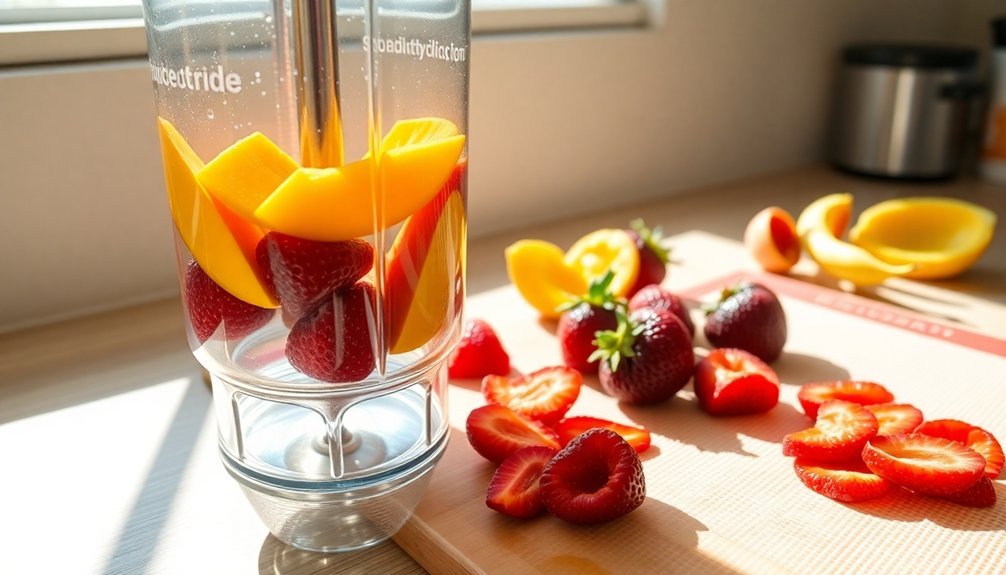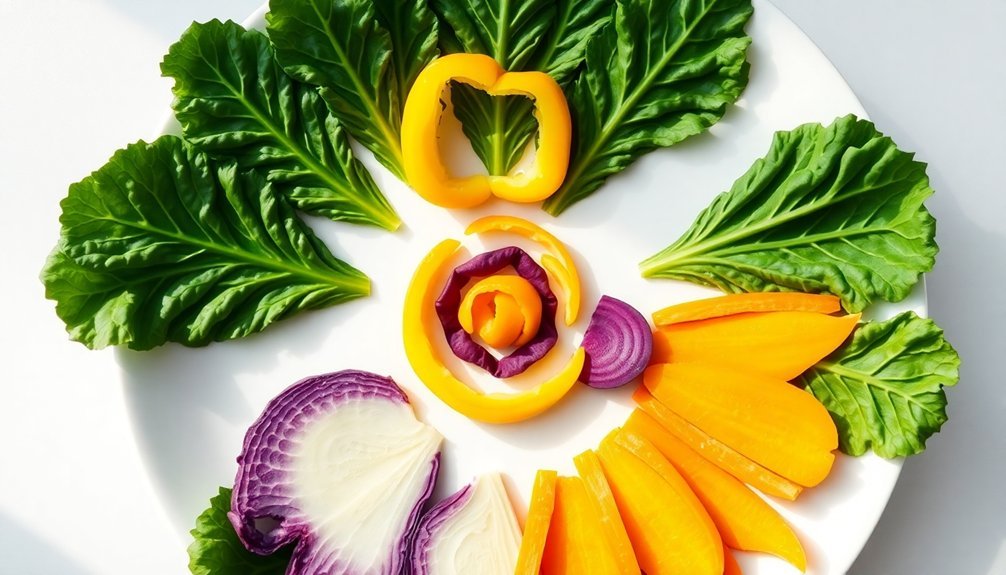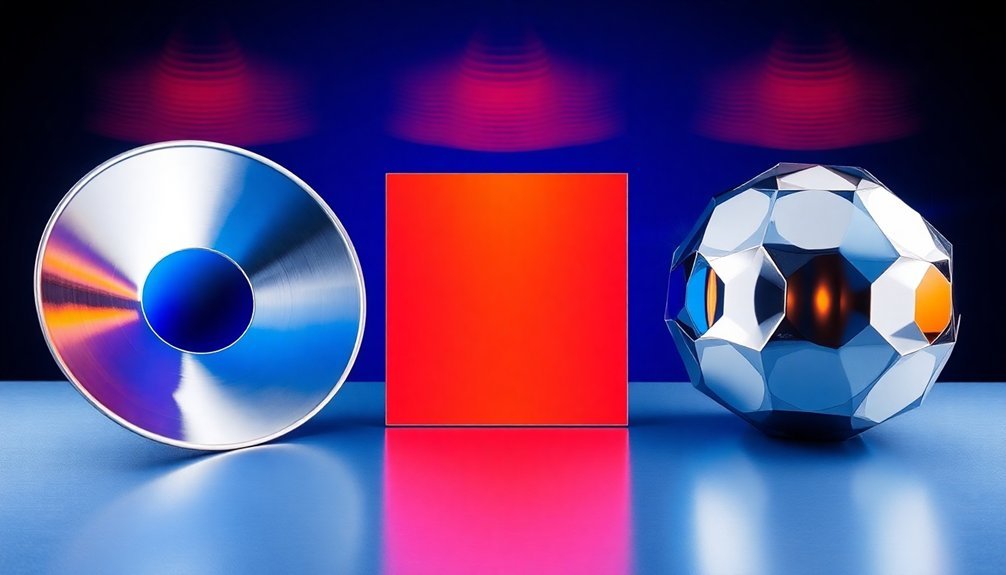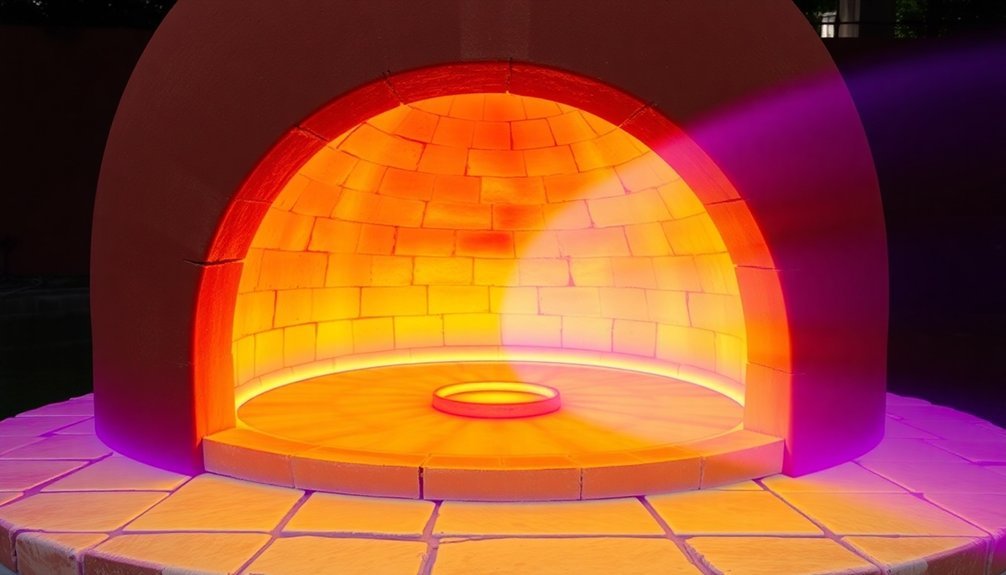You can create delicious sun-powered fruit leather by selecting ripe fruits, blending them into a smooth puree, and spreading the mixture thinly on a lined baking tray. Position your tray in direct sunlight between 10 AM and 4 PM, using reflective surfaces like aluminum foil to enhance heat collection. The drying process typically takes 4-7 hours in a solar dryer or a full day in direct sunlight. Once your fruit leather feels slightly tacky but not wet, wrap it in parchment paper and store in an airtight container. This eco-friendly snack will last up to 6 months in the refrigerator. Discover how to maximize your solar fruit leather's nutrition and flavor with proper techniques and tools.
Benefits of Solar Fruit Leather

Sustainability meets delicious snacking in sun-powered fruit leather making. You'll harness natural sunlight instead of electricity, greatly reducing your carbon footprint while creating nutritious treats. By utilizing solar energy outdoors, you're embracing an eco-friendly preservation method that minimizes reliance on electrical appliances. Covering your fruit puree with breathable fabric for protection ensures your treats stay bug-free during the drying process.
You're not just helping the environment – your health benefits too. Solar fruit leather retains more nutrients than high-heat drying methods, providing essential vitamins and minerals like vitamin C, potassium, and manganese. It's naturally low in fats and cholesterol, making it an ideal healthy snack option, especially for those monitoring sugar intake.
Your wallet will thank you as well. You'll save money by using leftover fruit pulp and cutting energy costs. The process requires only basic, inexpensive materials like parchment paper and cloth. By making large batches, you'll reduce your cost per serving while extending fruit shelf life and minimizing food waste.
The practical advantages are clear: you're creating portable, convenient snacks that don't need refrigeration. You can mix different fruit flavors and store your leather for extended periods, enhancing your food security with a durable, dried fruit product.
Essential Tools and Materials
Gathering the right tools and materials is vital for successful sun-powered fruit leather making.
You'll need a solar dryer or dehydrator as your main equipment, along with black baking trays to absorb heat and aluminum foil to reflect sunlight.
Don't forget dehydrator sheets or parchment paper and non-stick silicone mats to prevent sticking.
For preparation, you'll want a blender to puree your fruit, both chef's and paring knives for cutting, and a vegetable peeler.
A sturdy cutting board and spatulas are important for spreading your fruit mixture evenly.
To protect your creation from insects, you'll need a fly screen net, while skewers or sticks help secure the reflector tray.
Measuring tools guarantee accurate proportions, and a citrus juicer helps add lemon juice to preserve color.
You'll also need bricks for positioning trays and craft wood as optional spacers.
For storage, make certain you have greaseproof paper and airtight containers to keep your fruit leather fresh.
If you're using wood spacers, masking tape will help secure them in place.
Your fruit leather should dry for 4 to 6 hours in your solar dehydrator until the surface is smooth and touchable.
Selecting and Preparing Fruits

You'll want to start with perfectly ripe fruits, avoiding any that are under-ripe or overripe, since ripeness directly affects your leather's flavor and texture.
Clean your chosen fruits thoroughly, remove any damaged portions, and prepare them by peeling, pitting, or coring as needed before cutting into manageable chunks.
For optimal results, cut your fruit into smaller uniform pieces before blending.
Try combining complementary fruits like apple-blueberry or mixed berries for exciting flavor profiles, making sure to strain out any unwanted seeds or pulp after blending.
Choosing Peak Ripe Fruits
For the best sun-powered fruit leather, selecting perfectly ripe fruits is essential to your success.
You'll want to choose fruits that are at their peak flavor, displaying vibrant colors and giving off their signature fragrances. When you're checking ripeness, look for strawberries that are red throughout, peaches that emit a sweet aroma, and melons that sound hollow when tapped.
Select fruits that are heavy for their size and have a slight give when gently pressed, but avoid any that are bruised or overly soft. You can even use overripe fruits, as they're often sweeter and blend more smoothly into your puree.
If you're combining fruits, consider mixing high-pectin fruits like apples or pears with juicier options like berries or mangoes. The pectin will help your leather maintain its shape, while the juicy fruits add intense flavor.
Remember that seasonal fruits typically offer the best flavor and freshness. Try combinations like peach with raspberry or apple with cinnamon to create exciting flavor profiles.
Before drying, always taste your fruit puree and adjust the sweetness, as the flavors will concentrate during dehydration.
Cleaning and Prepping Produce
A kitchen full of fresh fruit awaits transformation into delicious fruit leather, but first you'll need to properly clean and prep your produce. Start by washing all your fruit thoroughly in cool water, removing any dirt, debris, or contaminants from the surface.
Pat the fruit dry to eliminate excess moisture that could affect the drying process. Next, remove all inedible parts including stems, peels, and seeds. Cut away any bruised areas or damaged portions to maintain the quality of your final product.
For berries, you'll want to press the puree through a fine mesh strainer later to eliminate unwanted seeds. Cut your cleaned fruit into uniform chunks that'll process easily in your blender or food processor.
You'll need about 2 cups of fruit for a 13" x 15" leather sheet. Once chopped, blend until you achieve a smooth, consistent puree. To prevent darkening and preserve color, add a splash of lemon juice or ascorbic acid to your mixture.
If you'd like to adjust the sweetness, you can incorporate honey, corn syrup, or sugar. For improved texture and reduced tartness, consider mixing in some applesauce before spreading your puree on drying trays.
Best Fruit Combinations
While many fruits work well for making fruit leather on their own, combining different varieties creates exciting flavors and improves overall texture. You'll get the best results by pairing high-pectin fruits like apples, plums, or cranberries with juicier options. These natural thickeners help achieve the perfect leather-like consistency.
Try classic combinations like blueberries with raspberries or strawberries with blackberries for a bold berry blend. If you're using tropical fruits, mix mango with pineapple or create a tropical medley by adding coconut and banana. For added depth, pair fruits with complementary spices – cinnamon works wonderfully with apple, while ginger enhances mango's natural sweetness.
When working with high water content fruits like melons or citrus, combine them with starchier fruits like bananas to achieve the right consistency. You can also enhance your mixtures with natural sweeteners like honey or maple syrup, but use them sparingly.
For extra flair, create a marbled effect by preparing two different fruit mixtures and swirling them together before drying. Remember to remove seeds from berries for a smoother texture, and always use fruits at peak ripeness for the best flavor.
Building Your Solar Dryer
Building your own solar fruit dryer starts with gathering the essential materials and tools.
You'll need galvanized steel poles (38mm) for the frame, polyethylene paper or polyurethane glass for the covering, and 1mm-thick mild steel sheets for heat absorption. Don't forget wood, like gmelina, for structural support and casing.
For the drying chamber, construct three layers of shelves using white net cloth, spacing them 0.5-1M apart. Make each shelf 1M wide and 14M long, reaching a total height of 2M.
Install a solar collector compartment with black-painted metal sheets to maximize heat absorption. You'll want to add reflective surfaces like aluminum foil to enhance heat collection.
Use your drill to create ventilation holes, and secure all components with galvanized screws. Add insulation (7cm thick) to prevent heat loss, and install a 500mm fan (240V, 180W) for proper air circulation.
Cover the collector and drying chamber with glass to trap solar radiation. For convenience, consider adding wheels to make your dryer mobile.
Finally, verify all metal screening and ventilation points are properly secured with staples or adhesive.
Spreading and Solar Positioning

Pour your fruit mixture onto the lined tray, using a flexible spatula to spread it evenly to a 1-2mm thickness while ensuring there aren't any air bubbles.
You'll want to position your tray in a spot that gets full sun throughout the day, ideally with good air circulation for efficient drying.
Cover the tray with breathable cloth suspended above the fruit mixture to keep bugs away, and don't forget to bring it inside at night to protect from dew.
Smooth Pour And Spread
For successful fruit leather, proper spreading and sun positioning are critical steps that can make or break your final product. Start by preparing your fruit puree to achieve an applesauce-like consistency. If you're using soft fruits like strawberries, add banana or mango to improve texture. For firmer fruits like apples, cook them into a compote before pureeing.
Line your surface with baking parchment or a silicone sheet – don't use wax paper as it'll stick. Using an offset spatula, spread the puree evenly to a thickness of 1/8 to 1/4 inch (2-5 mm). Confirm the center isn't thicker than the edges to prevent brittleness. Form the mixture into a square or rectangle for easier rolling later.
Place your prepared leather in direct sunlight in a warm, dry location. Cover it with cheesecloth or a screen to protect from insects and debris while maintaining air circulation.
You'll need to bring it inside at night and rotate the pan occasionally for even drying. Check progress by running your palm over the surface – it should feel smooth without creasing. It's ready when it's soft, slightly tacky, and consistently dry throughout.
Perfect Sun Angle Setup
Achieving the perfect sun angle elevates your fruit leather from sticky to sublime. Position your drying tray where it'll receive maximum sunlight exposure during peak hours between 10 AM and 4 PM.
You'll want to adjust the tray's position throughout the day as the sun moves across the sky to maintain ideal exposure.
Boost your drying efficiency by placing a reflective surface, like aluminum foil or a white sheet, around the tray to bounce additional sunlight onto your fruit leather.
Keep the area clear of shadows and obstacles that might block the sun's rays. If you're using a drying rack, adjust its height to capture the best angle of sunlight based on the time of day and season.
Don't forget to protect your creation from unwanted visitors. Cover the tray with cheesecloth or a clean screen, securing it firmly to prevent wind displacement.
You'll need to check on your fruit leather every few hours, not just to assess its dryness but also to remove any debris that might've settled on the protective covering.
When night falls, bring your fruit leather inside to shield it from moisture and nocturnal insects.
Monitoring the Drying Process
Successful sun-dried fruit leather requires close attention during the drying process, which typically takes 4-7 hours in a solar dryer or up to a full day in direct sunlight.
You'll need to bring your leather indoors overnight and return it to the sun the next morning if it's not completely dry by sunset.
Check your leather's progress by gently running your palm over the surface – it should feel slightly tacky but not wet. The texture you're aiming for is flexible and leathery, not brittle or cracking.
Test multiple spots across the leather to verify even drying, as some areas may dry faster than others.
To prevent uneven drying, spread your fruit mixture to a uniform thickness of 1-2mm before starting.
You'll want to rotate your drying trays periodically and check for any remaining wet spots. If you notice some sections drying faster than others, adjust your tray positions accordingly.
Watch out for condensation or sticky patches, as these can lead to mold growth.
If you spot any concerning areas, continue drying until the entire surface is uniformly tacky.
Storage and Preservation Methods

Once your fruit leather reaches the perfect dry consistency, proper storage will determine how long it stays fresh and delicious.
You'll want to wrap your homemade fruit leather in parchment or wax paper first, then store it in airtight containers or freezer bags to protect it from moisture and contaminants.
Keep your fruit leather in a cool, dry place between 60°F and 70°F, away from direct sunlight and heat sources.
If you're storing it at room temperature, choose a dark location to prevent light-induced degradation.
For longer storage, you've got two excellent options: refrigeration or freezing.
When refrigerating, place your wrapped fruit leather in an airtight container, and it'll stay fresh for up to 6 months.
Before eating, always check for any signs of mold or unusual odors.
For maximum shelf life, freeze your fruit leather.
Cut it into individual portions, wrap tightly in plastic wrap, and place in freezer bags.
Frozen fruit leather can last up to a year while maintaining its flavor, texture, and nutritional value.
When you're ready to enjoy it, let it thaw at room temperature for about 30 minutes.
Frequently Asked Questions
Can I Dry Fruit Leather on Cloudy Days or During Winter?
You shouldn't dry fruit leather on cloudy days or in winter, as there's insufficient sunlight and heat. Instead, use a dehydrator or oven for reliable results and proper temperature control year-round.
What Happens if Insects Land on the Fruit Leather While Drying?
If insects land on your fruit leather, they'll contaminate it with bacteria and pathogens. You'll need to discard affected areas. To prevent this, cover your fruit leather with cheesecloth or mesh while drying.
How Can I Prevent the Edges From Drying Faster Than the Center?
You'll prevent uneven drying by spreading the puree thinner in the center and thicker at the edges. Don't forget to rotate your trays regularly and check for consistent thickness during the drying process.
Is It Safe to Leave Fruit Leather Drying Outdoors Overnight?
It's not recommended to leave fruit leather out overnight. You'll risk spoilage from moisture, mold, and animal contamination. Instead, bring it inside and continue drying the next day for better safety.
Can I Use Frozen Fruits to Make Solar-Dried Fruit Leather?
Yes, you can use frozen fruits for solar-dried fruit leather. Just make sure you thaw them completely first, then blend them into a smooth puree. You'll need to drain excess liquid before spreading the mixture.
In Summary
You'll find making sun-powered fruit leather is an eco-friendly way to preserve seasonal fruits while capturing their peak flavors. With basic tools, fresh produce, and solar power, you've created healthy snacks that'll last for months. Keep experimenting with different fruit combinations and drying times to perfect your technique. Remember to store your leather properly, and you'll enjoy these homemade treats throughout the year.





Leave a Reply